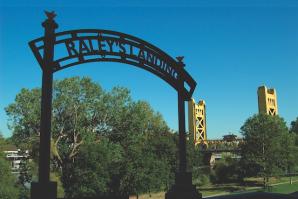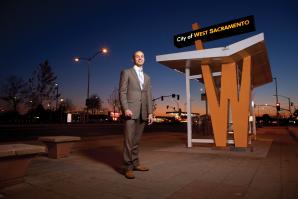West Capitol Avenue is looking pretty snazzy these days. Modern buildings with shiny, chrome lettering line clean, wide sidewalks. Newly planted trees lead to bright bus stops stylized with sculptured ‘W’s nearly 10 feet tall.
In the words of Capital Improvement manager Maureen Pascoe, “I like to say that the W stands for ‘wow.’ ”
After about 50 years of decline, West Sacramento’s West Capitol Avenue has been rejuvenated. First recommendations to upgrade the street came shortly after the city incorporated in 1987, but it wasn’t until Pascoe joined City Hall in 2003 that real change began.
“I’ve worked on the West Capitol Avenue project since the day I started. In fact, I was given this assignment along with an ‘I’m so sorry,’” she says. “It really seemed insurmountable.”
West Cap was once the main thoroughfare between Sacramento and the East Bay until freeways and bridges started absorbing the traffic in the 1960s. As cars dwindled, so did upkeep. Transit-oriented establishments went belly up, motels degraded along with their clientele, and when the street transitioned away from its auto-packed heyday, it lost local friendliness. With no dedicated bike lane, cyclists battled what traffic remained. Small sidewalks discouraged pedestrians, and several years of repaving created an elevated crown along the median.
“It was almost impassible for ped-estrians trying to cross,” says West Sacramento Mayor Christopher Cabaldon. “You were almost taking your life in your own hands.”
After years of efforts from Pascoe and the City Council — plus an intense 18-month construction revamp — West Capitol Avenue has evolved into the downtown city officials hoped for. In addition to housing City Hall, restaurants, two supermarkets, two major drug stores and a post office, the street has welcomed a college, community center and updated library and transit centers.
“It has all the ingredients of a downtown,” Pascoe says, “so we needed to create the look and feel of a downtown.”
The first step was changing what Pascoe calls the road’s “diet.”
“We decreased the ratio of the road from being 10 percent for people and 90 percent for cars to making it more like 60 percent for people and 40 percent for cars,” she says.
Spanning the half-mile between Jefferson Boulevard and Garden Street, the city encouraged foot traffic by reducing the number of vehicle lanes from four to two each way and increased the width of sidewalks to 20 feet. They added bike lanes and street parking and upgraded bus stops, landscaping and water and sewer systems.
The $7 million in streetscape refurbishments were funded chiefly by the Sacramento Area Council of Governments. “[SACOG] is interested in making investments here because the funds support the region’s Blueprint program,” Pascoe says.
The Blueprint program, which promotes sustainable infill city development, paid for 65 percent of the street upgrades, with the remaining funding provided by a combination of redevelopment money and utilities fees, she says.
Additional local, state and federal funds underwrote more growth across the street from City Hall at West Capitol Avenue and Merkley Street. Los Rios Community College’s $7.8 million extension sprung up, along with the renovated $7.3 million Arthur F. Turner Community Library and a $2 million transit center. The $10 million West Sacramento Community Center also welcomed its first guests, who now can access its art gallery, café, public meeting rooms, senior center, daycare center, preschool and small, black box theater.
“West Capitol Avenue has all the ingredients of a downtown, so we needed to create the look and feel of a downtown.”
Maureen Pascoe, capital improvement manager, West Sacramento
Pascoe says the upgrades have tripled activity in the area.
“It wasn’t the kind of place where you’d say, ‘Honey, let’s take the kids downtown to West Sac,’” Cabaldon says. “Now, on the weekend that’s a perfectly reasonable proposition for family activities.”
Cabaldon and Pascoe project the new environment won’t only attract local, public investment, but private dollars as well. “We’ve made a significant amount of community investment in recreating a main street for our community,” Cabaldon says. “It really is now time for the private sector to step forward.”
Investment already is visible. At the Jefferson Boulevard intersection, a prominent new Chase bank branch is covered in signage reading “Now Open.”
“This is what we’re after,” Pascoe says. “This is exemplary use for what you have in a downtown. Having a full-service bank branch here is exactly what we hoped would happen.”
Bryan Turner, principal of West Sacramento Land Co., which owns the property, says he was surprised by how much interest the site drew from potential tenants.
“Because of the streetscape improvements, Los Rios, the library and all the energy and focus paid to West Capitol Avenue, we had almost a disproportional amount of interest in that property,” he says.
What’s more, Turner adds, the quality of tenants has improved.
“Especially in this market, it’s rare to lose a tenant and be able to replace it with an even better tenant,” he says. “If the improvements hadn’t been made, we’d probably have a 7-Eleven there or a convenience market of some type.”
Existing businesses are keeping up with improvements, too. Ross Amin, owner of local hangout Capitol Bowl at West Capitol Avenue and Garden Street, invested more than $600,000 to refurbish his bowling alley’s kitchen, bar and reception area. Amin says he has enjoyed a 15 percent boost in business since upgrading the venue.
“I see more clients and better clients,” he says. “People like the new, clean area and a more family-friendly atmosphere.”
While more and better establishments are the new rule, remnants of the old West Cap still pepper the block — specifically, a few remaining dive motels and their patrons.
“The motels are not good for business,” Amin says. “They draw the wrong people sometimes. But it has improved.”
The 23-year-old Carol’s Restaurant sits adjacent to a motel. Owner Carol Baker says she’s seen a drop in what she calls an “unsavory” population. The change bolstered her already-large following.
“We’ve been busier,” she says. “I think the upgrades did make a
difference. More people like coming down now that the atmosphere
is cleaned up.”
Even more sprucing up is expected as the likely influx of incoming businesses organically phases out less-desirable establishments.
“We are making the street suitable for the desired kind of uses we want to attract here,” Pascoe says. “That may mean that some of the old uses will be bought out or remodeled to the new environment.”
West Cap’s improvements represent the beginning of more upgrades citywide, rippling out from the fresh-faced street to the waterfront’s Bridge District, which could soon provide a more regional-scale downtown.
However, needed redevelopment dollars might not be available for future city improvements. In January, the California Supreme Court ruled to disband state redevelopment agencies. That decision spells the end for such agencies unless lawmakers pass a new redevelopment plan.
Those funds would have allowed additional work to West Capitol Avenue, extending improvements to Sycamore Avenue by 2014 and, eventually, reaching Harbor Boulevard.
“Frankly, I don’t know how we will do that without redevelopment,” says Cabaldon, who, with Pascoe and others, is on the lookout for alternative funding sources. SACOG support is anticipated to continue for such projects, but its contributions are insufficient to cover all expenses.
Redevelopment dollars also would have helped bridge the current financing gap for the West Sacramento streetcar planned to run from West Capitol Avenue over Tower Bridge to downtown Sacramento.
“Voters approved a sales tax measure in 2008 to support the streetcar. Developers in the Bridge District and Raley’s Landing have pledged several million, and we have funds programmed in our Capital Improvement program,” Pascoe says. “But it doesn’t cover everything we expect we will need to contribute.”
With West Sacramento’s history of fiscal prudence, the breadth of upcoming redevelopment at a time of financial uncertainty has city officials scratching their heads.
“It’s a challenge on a scale we’ve never had to deal with before,” Cabaldon says.
Regardless of the loss of redevelopment dollars, the enthusiasm of city officials such as Pascoe and Cabaldon shines a bright light on the city’s vision for the future.
“You just have to walk across the Tower Bridge and see what’s going on in the waterfront or walk down West Capitol Avenue,” Cabaldon says. “You can see that vision as clear as day.”
Recommended For You

What the Waterfront
The evolution of West Sac’s shoreline
As a resident of fabulous West Sacramento, I was going to start this column with my standard opening line of “West Sac is the best Sac,” but flipping through the pages of our July ’92 issue, I found a quote from Val Toppenberg that said, “Cross-river bashing is not productive.” What a fun-killer.

Small City, Big Vision
Acuity with Chris Cabaldon
There is nobody more bullish on the City of West Sacramento than Mayor Chris Cabaldon. He says no city in the region can boast of a better location and, perhaps most importantly, a better water supply. With these two key attributes, the mayor believes the west-bank city is well positioned to attract business, jobs and residents for the foreseeable future.



